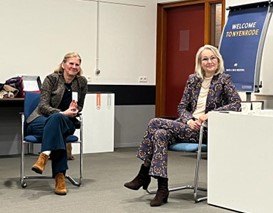Everything we buy has an impact on the planet, on society. Perhaps you already eat as much organic food as you can find and only use renewable energy sources to heat and light your house. For other categories – such as fashion, lifestyle and beauty – it is more challenging to find sustainable, circular options in retail stores.
Sustainable department store TOMO opened at the Mall of the Netherlands in March 2023. Its mission? To make sustainable the new norm in retail. With over 1,000 m2, it was an amazing place to explore sustainable retail. And to inspire people for other ways to reduce the impact of fashion – by offering circular services like repair, refill, rental and resale of high-end vintage items. A month later, team TOMO added a web shop to extend its reach – and there were plans to extend the concept abroad and to shop-in-shop formats in the Netherlands. But unfortunately, TOMO felt compelled to file for bankruptcy just four months later.
In October 2023, I had the privilege to stage and moderate an event for the Nyenrode Alumni Circle for Sustainability about the rise and fall of TOMO. We welcomed Marjan Haselhoff, founder of TOMO, together with Marjolein Mesman, who was part of TOMO’s core team. In an open and interactive way, they shared their key learnings from TOMO’s journey.
Talent
TOMO managed to attract some top-notch people to dedicate their talent and time. Some people only joined part-time, to limit the cash outflow. Others were eager to join in return for high salaries and/or large shares in the company, but this was not something the founders were willing to do. Jointly, the team possessed a lot of knowledge, but in hindsight, they could have done with more retail start-up knowledge in the team.
Despite its great mission, as an unknown employer, for TOMO it was still a challenge to recruit experienced salespeople. TOMO did recruit some very good salespeople, but the focus was on recruiting people with a shared passion for sustainability with the intent to train them on the job on the shop floor. But with little in-store traffic, this proved quite hard. And while the Friendly Performance Indicators – focused on the sustainability story – were very inspiring and tracking nicely, the sustainability passion of the hosts did not necessarily lead to the much-needed sales. In hindsight, it would have been better to invest in employer branding earlier on and to focus on attracting only experienced sales staff.
Transition
TOMO’s mission of making sustainable the norm in retail alludes to a great transition across the industry. There are so many issues to tackle in the fashion value chain, that no one along the chain can do alone. It requires collaboration and co-creation across an ecosystem of actors like: companies, government, NGOs, consumers, knowledge institutes, and financiers. Some really helped, like the many media channels that spread TOMO’s story and dreams.
Yet other actors in TOMO’s ecosystem loved talking about their lofty sustainability ambitions but were unwilling to walk the talk. And this is not just true at the organizational level, but also for many consumers. There is a huge gap between their sustainability intentions and their actual behavior, which affects many sustainable initiatives. In his reflection on the evening, Nyenrode Professor André Nijhof reflected on how TOMO could have rallied up more support across the different partners in its ecosystem – to close the gap and drive systemic change. Like the creation of an active community of conscious consumers acting as TOMO ambassadors, working together to create new language to engage others.

Time to think big
With a big ambition, TOMO needed time. Time to create partnerships with sustainable brands, time to create an active community around TOMO, time for customers to get acquainted with the new concept. And patience from investors, to give the concept time to develop, to scale, and prove itself. And while investors really bought into TOMO’s mission and scalability, they were not patient enough for TOMO to learn and develop in its first year, which is a minimal timeframe for a retail concept to prove itself.
When asked what they’d do differently if they could do it again, team TOMO was unanimous: find a way to buy more time. With a longer timeline, more financial buffers and more patient investors, they could have invested more in marketing, merchandising and retail expertise. And have proven the unique role of TOMO as a catalyst for change.
TOMO & retail tomorrow
But there’s hope yet for TOMO. Founder Marjan Haselhoff shared that there are several parties interested in the TOMO concept. She hopes that the potential buyer will benefit from the tremendous effort that went into TOMO so far, so the next team to try can take it forward more successfully. And we’re very grateful to Marjan and Marjolein for sharing their story with the Nyenrode Circle for Sustainability, so we can all integrate her learnings into our sustainable next steps – in fashion, in retail, and beyond.
This blog was written by Marjolein Baghuis and also appeared on the Nyenrode alumni website. To read about people, books, and other posts about sustainability, change, and communications, please subscribe in the right-hand column.

